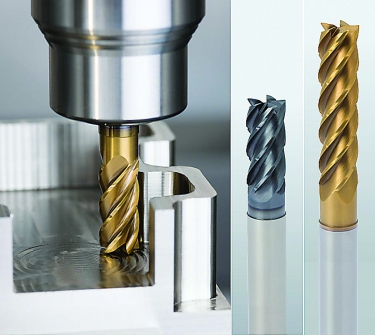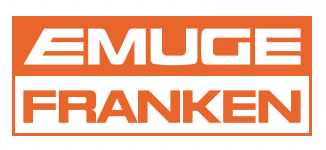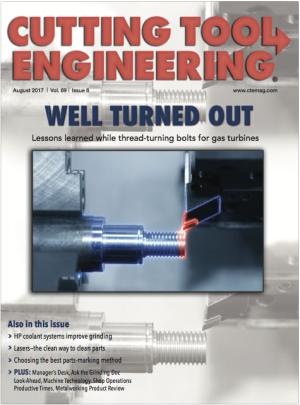Trochoidal milling is a relatively new cutting strategy that involves the overlapping of circular toolpaths with linear movement. It is well-suited for difficult-to-machine materials and thin-walled components.
The small contact angle on the tool reduces heat generation during machining and lowers thermal stress, which increases tool life. The endmill is fully utilized over the entire flute length. As a result, wear is evenly spaced over the full cutting edge, which also contributes to longer tool life. In addition, high metal-removal rates can be generated even on low-powered machines, and wear is reduced during full slot milling.
Emuge Corp. has just introduced a line of solid-carbide endmills designed specifically for trochoidal milling. The tool manufacturer reports that the line allows the user to increase removal rates more than 30 percent. It also enables a high axial DOC—up to 4 diameters deep, according to Emuge. The series was developed specifically for advanced milling strategies made possible by CAM software, which optimizes the calculation of milling paths and eliminates unproductive tool motion.

Emuge trochoidal endmills with chip-breaking geometry. Image courtesy of Emuge.
Dan Doiron, Emuge milling products manager, said the line’s new chipbreaker geometry reduces axial pullout force. It also minimizes the risk of chip buildup in pockets. The resulting smaller chips can be easily removed with compressed air or coolant.
“When the entire flute length of an endmill is utilized, as in trochoidal milling for the purpose of roughing, the next operation would normally be to select a nonchip-style mill to finish a wall, for example,” he said. “However, with our staggered chipbreaker geometry, the best of both designs are incorporated. Thus, using the same tool can enable aggressive cutting speeds followed by a conservative final finish pass.”
Emuge’s trochoidal endmills feature variable spacing, variable helix angles and improved microgeometry to minimize vibration, the company reports, along with new, high-performance coatings of TiN, TiAlN and AlCr, and a submicrograin-carbide substrate.
The endmills are available in two cutting geometries: Jet-Cut (for both roughing and finishing in steel applications) and Coolant-Through TiNox-Cut (for process-reliable roughing in tough materials such as Inconel, titanium and stainless steel). Standard and long-length rougher/finishers with flute length-to-diameter ratios of 2:1, 3:1 and 4:1 are available for applications in a range of materials.
For more information about Emuge Corp., West Boylston, Mass., visit www.emuge.com or call (800) 323-3013.
Contact Details
Related Glossary Terms
- chipbreaker
chipbreaker
Groove or other tool geometry that breaks chips into small fragments as they come off the workpiece. Designed to prevent chips from becoming so long that they are difficult to control, catch in turning parts and cause safety problems.
- computer-aided manufacturing ( CAM)
computer-aided manufacturing ( CAM)
Use of computers to control machining and manufacturing processes.
- coolant
coolant
Fluid that reduces temperature buildup at the tool/workpiece interface during machining. Normally takes the form of a liquid such as soluble or chemical mixtures (semisynthetic, synthetic) but can be pressurized air or other gas. Because of water’s ability to absorb great quantities of heat, it is widely used as a coolant and vehicle for various cutting compounds, with the water-to-compound ratio varying with the machining task. See cutting fluid; semisynthetic cutting fluid; soluble-oil cutting fluid; synthetic cutting fluid.
- endmill
endmill
Milling cutter held by its shank that cuts on its periphery and, if so configured, on its free end. Takes a variety of shapes (single- and double-end, roughing, ballnose and cup-end) and sizes (stub, medium, long and extra-long). Also comes with differing numbers of flutes.
- gang cutting ( milling)
gang cutting ( milling)
Machining with several cutters mounted on a single arbor, generally for simultaneous cutting.
- milling
milling
Machining operation in which metal or other material is removed by applying power to a rotating cutter. In vertical milling, the cutting tool is mounted vertically on the spindle. In horizontal milling, the cutting tool is mounted horizontally, either directly on the spindle or on an arbor. Horizontal milling is further broken down into conventional milling, where the cutter rotates opposite the direction of feed, or “up” into the workpiece; and climb milling, where the cutter rotates in the direction of feed, or “down” into the workpiece. Milling operations include plane or surface milling, endmilling, facemilling, angle milling, form milling and profiling.
- milling machine ( mill)
milling machine ( mill)
Runs endmills and arbor-mounted milling cutters. Features include a head with a spindle that drives the cutters; a column, knee and table that provide motion in the three Cartesian axes; and a base that supports the components and houses the cutting-fluid pump and reservoir. The work is mounted on the table and fed into the rotating cutter or endmill to accomplish the milling steps; vertical milling machines also feed endmills into the work by means of a spindle-mounted quill. Models range from small manual machines to big bed-type and duplex mills. All take one of three basic forms: vertical, horizontal or convertible horizontal/vertical. Vertical machines may be knee-type (the table is mounted on a knee that can be elevated) or bed-type (the table is securely supported and only moves horizontally). In general, horizontal machines are bigger and more powerful, while vertical machines are lighter but more versatile and easier to set up and operate.
- titanium aluminum nitride ( TiAlN)
titanium aluminum nitride ( TiAlN)
Often used as a tool coating. AlTiN indicates the aluminum content is greater than the titanium. See coated tools.
- titanium nitride ( TiN)
titanium nitride ( TiN)
Added to titanium-carbide tooling to permit machining of hard metals at high speeds. Also used as a tool coating. See coated tools.



